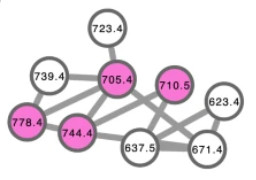
|
[GT] 인공 지능을 활용한 천연 약물 탐구 | |||
| 카네기 멜론 대학교 컴퓨터 공학부 컴퓨터 생물학과 연구원들은 암, 바이러... |


  |
 |  |
 |
[GT] 인공 지능을 활용한 천연 약물 탐구
카네기 멜론 대학교 컴퓨터 공학부 컴퓨터 생물학과 연구원들은 암, 바이러스 감염 및 기타 질병을 치료하기 위한 천연 약물을 검색하는 새로운 프로세스를 개발했다.
이 기계 학습 알고리즘은 미생물 대사 산물의 신호를 게놈 신호와 일치시키고, 어느 것이 천연 제품에 해당할 가능성이 있는지를 식별할 수 있다. 이를 통해, 연구자들은 천연물을 분리하고 이를 통해 가능한 약물을 개발할 수 있는 더 나은 장비를 갖추게 되었다.
‘내추럴 커뮤니케이션즈(Nature Communications)’에 발표된 이 새로운 연구에서 연구팀은 약 200종의 미생물에 대한 대사체학(metabolomics)적 및 게놈 데이터를 스캔할 수 있었다. 대사체학은 대사물질을 분석해 숨어 있는 돌연변이를 찾아내는 학문으로, 유전체의 염기서열을 결정해 알려지지 않은 새로운 유전자의 기능을 연구하는 유전체기능학의 하위개념이다.
이 연구팀의 새로운 알고리즘은 연구자들이 발견할 것으로 예상한 수백 가지의 천연 약물을 식별했을 뿐만 아니라 미래의 약물 개발에 유망한 것으로 보이는 4개의 새로운 천연물도 발견했다.
‘내추럴 커뮤니케이션즈’는 이 연구팀이 개발한 NPR 마이너(NRP-miner)에 대해서고 개괄적인 설명을 하는데, 이것은 ‘비 리보솜 펩티드(non-ribosomal peptides, NRP)를 발견하는 데 도움이 되는 인공지능이다.
NRP는 중요한 형태의 천연물로 수많은 항생제, 항암제 및 기타 임상용으로 약물을 만드는 데 사용된다. 그러나 감지해내는 것이 어렵고 잠재적으로 유용한 것인지를 식별하는 것은 훨씬 더 어렵다.
연구팀이 접근한 방식은 기술이 매우 민감하다는 특성이 있다. 이 기술을 통해 나노그램의 풍부한 분자를 감지할 수 있고, 이에 지금까지는 찾기 힘들었던 새로운 것들을 발견할 수 있다.
천연물 발견은 오랜 시간과 노동이 투입되는 노동 집약적 연구의 결과이다. 실제로 상당한 시간과 수백만 달러의 비용이 소요되고 있어, 주요 제약 회사는 지난 수십 년 동안 새로운 천연 제품에 대한 탐색을 대부분 포기해왔다. 바로 이 점에서 이 연구팀의 성과는 매우 중요한 의미가 있다. 유전체학 연구에 기계 학습 알고리즘을 적용함으로써 유익할 수 있는 천연물을 식별 분리할 수 있는 새로운 기회를 창출했기 때문이다.
연구팀의 목표는 다양한 실험과 연구, 탐색을 통해 다양한 천연 약물 후보를 발견한 후, 이를 제약 회사와 함께 매력적인 단계로 개발하는 것이다. 이에 연구팀은 ’NPR 마이너‘의 발견 방식을 상업화에 적합한 규모로 키워 다양한 종류의 천연 제품으로 연구를 확장하고 있다. 연구팀은 초기 연구에서 발견된 4개의 새로운 천연물을 계속 연구하고 있으며, 이 중 2개는 잠재적인 항말라리아 특성이 있는 것으로 밝혀졌습니다.
- NATURE COMMUNICATIONS, May 28, 2021, “Integrating genomics and metabolomics for scalable non-ribosomal peptide discovery,” by Bahar Behsaz, et al. © 2021 Springer Nature Communications. All rights reserved.
To view or purchase this article, please visit:
 |  |
 |
Integrating genomics and metabolomics for scalable non-ribosomal peptide discovery
Researchers from Carnegie Mellon University’s Computational Biology Department in the School of Computer Science have developed a new process to search for natural product drugs to treat cancers, viral infections and other ailments.
The machine learning algorithms match the signals of a microbe’s metabolites with its genomic signals and identify which likely correspond to a natural product. Knowing that, researchers are better equipped to isolate the natural product and develop it for a possible drug.
In a new study published in Nature Communications, the team was able to scan the metabolomics and genomic data for about 200 strains of microbes. Their new algorithm not only identified the hundreds of natural product drugs the researchers expected to find, but it also discovered four novel natural products that appear promising for future drug development.
The publication outlines the team’s development of NRP-miner, an artificial intelligence tool to aid in discovering non-ribosomal peptides (or NRPs). NRPs are an important type of natural product and are used to make many antibiotics, anticancer drugs and other clinically used medications. They are, however, difficult to detect and even more difficult to identify as potentially useful.
What is unique about this approach is that the technology is very sensitive. It can detect molecules with nanograms of abundance. Therefore, it can discover things that are hid- den under the grass.
That’s important because, uncovering natural products is time and labor intensive, often taking years and millions of dollars. Consequently, major pharmaceutical companies have mostly abandoned the search for new natural products in the past decades.
By applying machine learning algorithms to the study of genomics, however, researchers have created new opportunities to identify and isolate natural products that could be beneficial.
The team’s objective is to push this forward and discover other natural drug candidates and then develop those into a phase that would be attractive to pharmaceutical companies. To do so they are expanding the NPR-miner’s discovery methods to different classes of natural products at a scale suitable for commercialization. The team is already investigating the four new natural products discovered during their initial study and two have been found to have potential antimalarial properties.
Reference:
- NATURE COMMUNICATIONS, May 28, 2021, “Integrating genomics and metabolomics for scalable non-ribosomal peptide discovery,” by Bahar Behsaz, et al. © 2021 Springer Nature Communications. All rights reserved.
To view or purchase this article, please visit:

.jpg)
.jpg)
.jpg)

